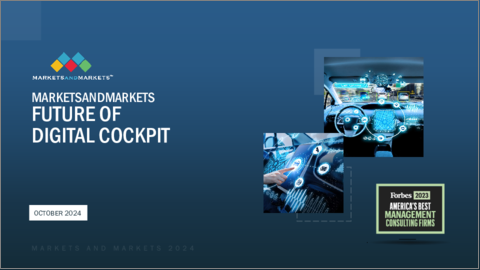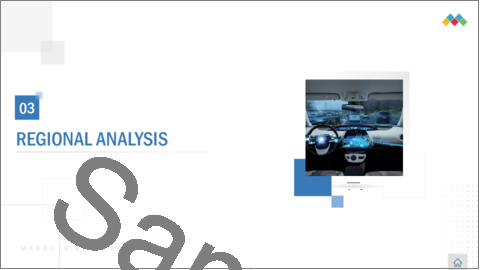|
|
市場調査レポート
商品コード
1580104
デジタルコックピットの世界市場:タイプ別、セグメント別、ディスプレイサイズ別、地域別 - 2030年までの予測Future of Digital Cockpit Market by Type (ICE,EV), Segment (Entry, Mid & High End Cockpit), Display Size (<10", 10-15", >15"), and Region (North America, Europe and Asia-Pacific) - Global Forecast 2030 |
||||||
カスタマイズ可能
|
|||||||
| デジタルコックピットの世界市場:タイプ別、セグメント別、ディスプレイサイズ別、地域別 - 2030年までの予測 |
|
出版日: 2024年10月17日
発行: MarketsandMarkets
ページ情報: 英文 112 Pages
納期: 即納可能
|
- 全表示
- 概要
- 図表
- 目次
デジタルコックピットの市場規模は、2024年の4,500万台から2030年には6,700万台に達し、CAGRは7.0%になると予測されています。
OEMは、顧客の期待が高まるにつれ、コストの上昇と車載エレクトロニクスの複雑化に直面しています。そのため、自動車メーカー各社は、コスト削減と電子アーキテクチャの簡素化に役立つコックピットのドメイン集中化に関して緊密に協力しています。そのため、ティア1サプライヤーはすでに、インフォテインメントシステムとクラスターなどの安全システムの統合を開始しています。例えば、BMW iXは曲面ディスプレイ(14.9インチ中央インフォテインメント+12.3インチクラスターディスプレイ)を採用し、Tesla Model 3は中央インフォテインメントとクラスターディスプレイを組み合わせた15インチディスプレイを採用しています。
| 調査範囲 | |
|---|---|
| 調査対象年 | 2020年~2030年 |
| 基準年 | 2024年 |
| 予測期間 | 2024年~2030年 |
| 検討単位 | 金額(単位) |
| セグメント | ディスプレイソリューション別、ディスプレイサイズ別、地域別 |
| 対象地域 | 北米、欧州、アジア太平洋 |
電気自動車におけるデジタルコックピットソリューションの需要は、ICE乗用車よりも高くなっています。現在、EVにおけるデジタルコックピットの世界の普及率は、2023年には85~90%に達しましたが、ICE乗用車では50~55%です。EVの販売は世界中で飛躍的に伸びており、今後数年でICE乗用車を追い抜くと予想されています。デジタルコックピットの40%以上は、ADAS機能、スマート・コネクティビティ、リアルタイム車両モニタリングなど、電気自動車で必要とされる高度な機能を備えています。したがって、デジタルコックピットの需要は、ICE車と比較してEV車において高くなっています。
QNX、Linux、Androidは、デジタルコックピットを支える3つの主要オペレーティングシステムです。オペレーティングシステムは、インタラクティブなディスプレイ、直感的なタッチインターフェイス、シームレスな接続性を担っています。多くのOEMは依然としてQNXを好んでおり、ADAS、OTAアップデートなど、高い信頼性と安全性を伴うリアルタイムの操作と機能を担当しています。Linuxはオープンソースのプラットフォームで、インフォテインメント、ナビゲーション、コネクテッドサービスに適しています。
当レポートでは、世界のデジタルコックピット市場について調査し、ディスプレイソリューション別、ディスプレイサイズ別、地域別動向、および市場に参入する企業のプロファイルなどをまとめています。
目次
- デジタルコックピット市場の定義
- エントリー、ミッド、ハイエンドコックピットの定義
- デジタルコックピットテクノロジー- ハードウェアとソフトウェア
- デジタルコックピット市場の主なハイライト
- 世界および地域の市場情勢
- セグメント別競合マトリックス
- マスマーケットおよびプレミアムOEM機能分析
- マスマーケットとプレミアムOEMの収益化戦略
- ディスプレイサイズと位置別OEM競合マトリックス
- デジタルコックピット市場、ディスプレイソリューション別(地域別規模、2020年~2030年)
- ローエンドバリアントコックピット
- ミッドエンドバリアントコックピット
- プレミアムエンドバリアントコックピット
- デジタルコックピット市場、ディスプレイサイズ別(地域別規模、2023年)
- 10インチ未満
- 10~15インチ
- 15インチ超
- デジタルコックピット市場、地域/国別(地域別規模、2020年~2030年)
- 欧州
- 北米
- アジア(中国、インド、日本、韓国)
- デジタルコックピット:サプライヤーの競合情勢
- 中国:コックピットモジュール部品サプライヤーとその顧客
- 欧州および北米:コックピットモジュール部品サプライヤーとその顧客
- 世界トップクラスのチップサプライヤー
- 中国:現地のチップサプライヤー
- オペレーティングシステム:OEMとその次世代OS
- デジタルコックピットの技術ロードマップ
- テクノロジー動向
- パーソナライゼーションの動向
- AIの影響とユースケース
- 特集動向
- ナビゲーション
- メディア
- VPA
- アプリストア
- ADAS統合
- ヘッドアップディスプレイ
- XPENG
- GEELY ZEEKR
- NIO
- LEAPMOTORS
- TATA MOTORS
- HONDA ACURA
- VOLKSWAGEN AUDI
- BMW
- MERCEDES-BENZ
- RIVIAN
- STELLANTIS
- FORD MOTORS
- GM
List of Tables
_
List of Figures
_
The digital cockpit market is projected to reach 67 million units by 2030 from 45 million units in 2024, at a CAGR of 7.0%. OEMs face rising costs and increased in-vehicle electronics complexity as customer expectations rise. Hence, automotive OEMs are working closely regarding the domain centralization of the cockpit, which will help reduce costs and simplify the electronic architecture. Hence, Tier 1 suppliers have already started integrating infotainment systems with safety systems such as clusters. For instance, the BMW iX features a curved display (14.9" central infotainment + 12.3" cluster display), and the Tesla Model 3 features a 15" display combining the central infotainment and cluster display.
| Scope of the Report | |
|---|---|
| Years Considered for the Study | 2020-2030 |
| Base Year | 2024 |
| Forecast Period | 2024-2030 |
| Units Considered | Value (Units) |
| Segments | Display solution, display size and propulsion |
| Regions covered | North America, Europe and Asia-Pacific |
Demand for Larger Central Infotainment Display
The demand for >15" center infotainment displays is gaining pace globally. The penetration of 10-15" displays is ~51%, and that of >15" will ~ be 7% in 2023. In Europe, the majority of center infotainment displays fall in the 10-15" category, with models such as the VW Passat, Audi A3, Porsche Panamera, Mercedes C-Class, BMW 3 series, and others. China follows the same trends with maximum models with 10-15" center infotainment displays. In APAC (excl. China), the <10" category holds the maximum share as compared to 10-15" displays, however, the OEMs are slowing moving towards the large center infotainment display.
Demand for digital cockpit in EVs
The demand for digital cockpit solutions in electric vehicles is higher than in ICE passenger cars. The current penetration of digital cockpits in EVs globally will be ~85-90% in 2023; however, in ICE passenger cars, the penetration is ~50-55%. EV sales are growing exponentially across the globe and are expected to overtake ICE cars in the coming years. More than ~40% of the digital cockpits are equipped with advanced features such as ADAS features, smart connectivity, real-time vehicle monitoring, and others, which are required in electric vehicles. Hence, the demand for digital cockpits is higher in EVs as compared to ICE cars.
OEMs moving towards in-house operating system
The QNX, Linux, and Android are the three key operating systems behind the digital cockpit. The operating system is responsible for interactive displays, intuitive touch interfaces, and seamless connectivity. Many OEMs still prefer QNX and is responsible for real-time operations and features that involve high reliability and safety, such as ADAS, OTA updates, and others. Linux is an open-source platform that is suitable for infotainment, navigation, and connected services. Android Automotive OS (AAOS) is expected to become the dominant automotive operating system in newly connected vehicles by 2025, outpacing QNX and Automotive Grade Linux (AGL) in market share. Android Automotive OS is the most logical choice for most carmakers due to its open-source nature and the vast ecosystem of over 3 billion IoT devices with access to the Google Play Store. Many OEMs are manufacturing the operating system in-house, such as Mercedes Benz (MB.OS), Rivian, Xpeng (Tianji XOS), NIO (Sky OS), Zeekr (Zeekr OS), Audi(developed with Cariad), and others. In-house development helps OEMs retain full product ownership, quicker iterations, and enhanced responsiveness to clients' needs.
"Asia Pacific holds the largest market share in the forecast period"
Asia Pacific has emerged as a promising global digital cockpit market. The principal driver of this trend is the Chinese market, which contribute ~40% to EV+ICE passenger car sales globally in 2023. India, Japan, and South Korea are potential country-level markets in the region. While India is gradually becoming a major contributor to the digital cockpit market, Japan and South Korea are already well-established.
The penetration of digital cockpits in China for ICE passenger cars is ~55-60%, and that of EVs is ~90-95% in 2023. The penetration is expected to grow exponentially till 2030, owing to the presence of key OEMs such as BYD, Xpeng, NIO, Leapmotors, Geely, and others. China is leading the EV sales accounting for ~65% of the global electric vehicles sold in 2023. China is leading the way in integrating advanced technologies into vehicle design, particularly by developing digital cockpits. Chinese EV OEMs are accelerating their acquisition of domestic chips to reduce reliance on imported components. In 2023, local cockpit SoCs in China captured approximately 4.8% of the passenger car market. With supportive policies and technological advancements, this share is anticipated to increase to 25% by 2030. Some local SoC suppliers are SemiDrive, SiEngine, AutoChips, and Huawei. Hence, China is focusing on a localization strategy to help them gain a competitive advantage in the global market.
Apart from China, other countries such as India, Japan, and South Korea contribute significantly to the digital cockpit market. Furthermore, the market growth in Asia Pacific can be attributed to the high vehicle production and increased use of advanced electronics in Japan, South Korea, and China. These countries' governments have recognized the automotive sector's growth potential and have consequently undertaken various initiatives to encourage major OEMs to enter their domestic markets. Several global automobile manufacturers, such as Volkswagen (Germany), Mercedes Benz (Germany), and General Motors (US), have shifted their production plants to emerging economies in the region.
Research Coverage:
The market analysis encompasses the digital cockpit market, focusing on its penetration in ICE and EV vehicles. The report covers regional digital cockpit trends, technology trends, feature analysis, BOM analysis, and OEM profiling. Geographically, the report covers North America, Europe, and Asia-Pacific.
Report Scope
The report will help market leaders and new entrants with information on the closest approximations of the digital cockpit market and its subsegments. It will also help stakeholders understand the competitive landscape and gain more insights to better position their businesses and plan suitable go-to-market strategies. The report also helps stakeholders understand the market pulse and provides information on key market drivers, restraints, challenges, and opportunities.
The report provides insights on the following pointers:
- Analysis of propulsion (ICE & EV)
- Analysis of display solution (<10", 10-15", 15")
- Analysis by region/country (China, APAC (excl. China), Europe, NA)
- Product Development/Innovation: Detailed insights on upcoming technologies, research & development activities, and new product & service launches in the digital cockpit market
- Market Development: Comprehensive information about lucrative markets - the report analyses the digital cockpit market across varied regions
- Market Diversification: Exhaustive information about the diversification of technology, untapped features, recent developments, and investments in the digital cockpit market
- Competitive Assessment: The report assesses the market shares, growth strategies, and service offerings of leading players. It also helps stakeholders understand the pulse of the digital cockpit market and provides information on key market drivers, challenges, and opportunities.
TABLE OF CONTENTS
1. MARKET DEFINITION & DIGITAL COCKPIT TECHNOLOGY
- 1.1 DIGITAL COCKPIT MARKET DEFINITION
- 1.2 ENTRY, MID & HIGH END COCKPIT DEFINITION
- 1.3 DIGITAL COCKPIT TECHNOLOGY- HARDWARE & SOFTWARE
2. STUDY SCOPE & OBJECTIVES
3. EXECUTIVE SUMMARY
- 3.1 DIGITAL COCKPIT MARKET KEY HIGHLIGHTS
- 3.2 GLOBAL & REGIONAL MARKET LANDSCAPE
- 3.3 COMPETITIVE MATRIX, BY SEGMENT
- 3.4 MASS-MARKET & PREMIUM OEMS FEATURE ANALYSIS
- 3.5 MASS-MARKET & PREMIUM OEMS MONETIZATION STRATEGIES
- 3.6 OEM COMPETITIVE MATRIX, BY DISPLAY SIZE AND POSITION
4. DIGITAL COCKPIT- REGIONAL ANALYSIS
- 4.1 DIGITAL COCKPIT MARKET,BY DISPLAY SOLUTION (REGIONAL VOLUME, 2020-2030)
- 4.1.1 LOW-END VARIANT COCKPIT
- 4.1.2 MID-END VARIANT COCKPIT
- 4.1.3 PREMIUM END VARIANT COCKPIT
- 4.2 DIGITAL COCKPIT MARKET, BY DISPLAY SIZES (REGIONAL VOLUME, 2023)
- 4.2.1 <10"
- 4.2.2 10-15"
- 4.2.3 >15"
- 4.3 DIGITAL COCKPIT MARKET, BY REGION/COUNTRY (REGIONAL VOLUME, 2020-2030)
- 4.3.1 EUROPE
- 4.3.2 NORTH AMERICA
- 4.3.3 ASIA (CHINA, INDIA, JAPAN, SOUTH KOREA)
5. DIGITAL COCKPIT SUPPLIER ANALYSIS
- 5.1 DIGITAL COCKPIT: SUPPLIER COMPETITIVE LANDSCAPE
- 5.2 CHINA: COCKPIT MODULE COMPONENT SUPPLIERS AND THEIR CUSTOMERS
- 5.3 EUROPE & NA: COCKPIT MODULE COMPONENT SUPPLIERS AND THEIR CUSTOMERS
- 5.4 GLOBAL LEADING CHIP SUPPLIERS
- 5.5 CHINA: LOCAL CHIP SUPPLIERS
- 5.6 OPERATING SYSTEM: OEMS & THEIR NEXT-GEN OS
6. TECHNOLOGY ROADMAP
- 6.1 TECHNOLOGY ROADMAP OF DIGITAL COCKPIT
- 6.2 TECHNOLOGY TRENDS
- 6.3 PERSONALIZATION TRENDS
- 6.4 AI IMPACT & USE CASES
- 6.5 FEATURE TRENDS
7. DIGITAL COCKPIT- FEATURE ANALYSIS
- 7.1 NAVIGATION
- 7.2 MEDIA
- 7.3 VPA
- 7.4 APP STORE
- 7.5 ADAS INTEGRATION
- 7.6 HUD
8. DIGITAL COCKPIT- BOM & MONETIZATION STRATEGY
9. DIGITAL COCKPIT OEM PROFILES
- 9.1 XPENG
- 9.1.1 COMPANY SNAPSHOT & DEVELOPMENTS
- 9.1.2 CURRENT AND NEXT-GEN COCKPIT DETAILS
- 9.1.3 FEATURE ANALYSIS
- 9.2 GEELY ZEEKR
- 9.2.1 COMPANY SNAPSHOT & DEVELOPMENTS
- 9.2.2 CURRENT AND NEXT-GEN COCKPIT DETAILS
- 9.2.3 FEATURE ANALYSIS
- 9.3 NIO
- 9.3.1 COMPANY SNAPSHOT & DEVELOPMENTS
- 9.3.2 CURRENT AND NEXT-GEN COCKPIT DETAILS
- 9.3.3 FEATURE ANALYSIS
- 9.4 LEAPMOTORS
- 9.4.1 COMPANY SNAPSHOT & DEVELOPMENTS
- 9.4.2 CURRENT AND NEXT-GEN COCKPIT DETAILS
- 9.4.3 FEATURE ANALYSIS
- 9.5 TATA MOTORS
- 9.5.1 COMPANY SNAPSHOT & DEVELOPMENTS
- 9.5.2 CURRENT AND NEXT-GEN COCKPIT DETAILS
- 9.5.3 FEATURE ANALYSIS
- 9.6 HONDA ACURA
- 9.6.1 COMPANY SNAPSHOT & DEVELOPMENTS
- 9.6.2 CURRENT AND NEXT-GEN COCKPIT DETAILS
- 9.6.3 FEATURE ANALYSIS
- 9.7 VOLKSWAGEN AUDI
- 9.7.1 COMPANY SNAPSHOT & DEVELOPMENTS
- 9.7.2 CURRENT AND NEXT-GEN COCKPIT DETAILS
- 9.7.3 FEATURE ANALYSIS
- 9.8 BMW
- 9.8.1 COMPANY SNAPSHOT & DEVELOPMENTS
- 9.8.2 CURRENT AND NEXT-GEN COCKPIT DETAILS
- 9.8.3 FEATURE ANALYSIS
- 9.9 MERCEDES-BENZ
- 9.9.1 COMPANY SNAPSHOT & DEVELOPMENTS
- 9.9.2 CURRENT AND NEXT-GEN COCKPIT DETAILS
- 9.9.3 FEATURE ANALYSIS
- 9.10 RIVIAN
- 9.10.1 COMPANY SNAPSHOT & DEVELOPMENTS
- 9.10.2 CURRENT AND NEXT-GEN COCKPIT DETAILS
- 9.10.3 FEATURE ANALYSIS
- 9.11 STELLANTIS
- 9.11.1 COMPANY SNAPSHOT & DEVELOPMENTS
- 9.11.2 CURRENT AND NEXT-GEN COCKPIT DETAILS
- 9.11.3 FEATURE ANALYSIS
- 9.12 FORD MOTORS
- 9.12.1 COMPANY SNAPSHOT & DEVELOPMENTS
- 9.12.2 CURRENT AND NEXT-GEN COCKPIT DETAILS
- 9.12.3 FEATURE ANALYSIS
- 9.13 GM
- 9.13.1 COMPANY SNAPSHOT & DEVELOPMENTS
- 9.13.2 CURRENT AND NEXT-GEN COCKPIT DETAILS
- 9.13.3 FEATURE ANALYSIS
10. FINAL TAKEAWAYS
11. APPENDIX






